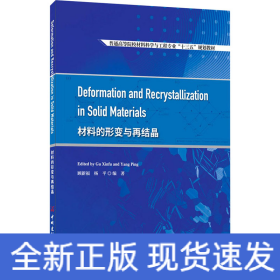
材料的形变与再结晶
全新正版 假一赔十 可开发票
¥ 50.26 6.4折 ¥ 78 全新
仅1件
北京东城
认证卖家担保交易快速发货售后保障
作者顾新福,杨平 编
出版社中国建材工业出版社
ISBN9787516032374
出版时间2021-08
装帧平装
开本16开
定价78元
货号1202463550
上书时间2024-12-23
- 最新上架
商品详情
- 品相描述:全新
- 商品描述
-
目录
Part One
1 Introduction
1.1 Why this book
1.1.1 Deformation-recrystallization and their microstructure
1.1.2 Examples of industrial applications
1.2 Relationship between this course and other major courses
1.3 Contents in this book
1.4 How to learn
1.5 Exercises
2 Deformation of materials
2.1 Learning objectives
2.2 Introduction
2.3 Plastic deformation in a single crystal
2.3.1 Slip systems
2.3.2 Slip lines and slip bands
2.3.3 Schmid s law
2.3.4 Cross slip
2.3.5 Multiple-slip
2.3.6 Determine the slip system
2.3.7 Rotation of crystals during tension and compression
2.3.8 Stress-strain curve of single crystals
2.3.9 Upper-lower yielding effects
2.3.10 Work hardening
2.3.11 Mechanical twinning
2.3.12 Slip vs twinning
2.3.13 Stress-strain curve during twinning
2.4 Plastic deformation in polycrystalline materials
2.4.1 Features of poly-crystalline deformation and role of grain boundary
2.4.2 Deformation of bi-crystals
2.4.3 Macro-accommodation. five independent slip systems
2.4.4 Deformed microstructure
2.4.5 HalI-Petch relationship
2.5 Deformation texture
2.5.1 Description of crystal orientation
2.5.2 Orientation distribution
2.5.3 Classification of deformation textures
2.6 Deformation of polymers
2.6.1 Amorphous thermoplastics
2.6.2 Semi-crystalline thermoplastics
2.7 Summary
2.8 Exercises
Part Two
3 Recrystallization of materials
3.1 Learning objectives
3.2 Introduction
3.3 Thermodynamics consideration
3.4 Recovery of deformed metals
3.4 Basic features
3.4 Recoveries of physical and mechanical properties
3.4 Kinetics of recovery
3.4 Microstructure evolution during recovery
3.5 Recrystallization of materials
3.5 Introduction
3.5 Basic laws of recrystallization
3.5 Recrystallization kinetics
3.5 Factors affecting the kinetics of recrystallization
3.5 Nucleation and growth during recrystallization
3.5 Effects of secondary particles
3.6 Grain growth after recrystallization
3.6.1 Introduction
3.6.2 Normal grain growth and annealing twins
3.6.3 Abnormal grain growth or secondary recrystaltization
3.7 Recrystallization textures and their control
3.7.1 Typical recrystallization textures in metals and alloys
3.7.2 Texture evolution during grain growth
3.7.3 Theories of recrystallization texture
3.7.4 Applications
3.8 Summary
3.9 Exercises
4 Hot deformation of materials
4.1 Learning objectives
4.2 Introduction
4.3 Dynamic recovery
4.3.1 Stress-strain curve in dynamic recovery
4.3.2 Mechanism of microstructure evolution during recovery
4.4 Dynamic recrystallization
4.4.1 Stress-strain curve in dynamic recrystallization
4.4.2 Dynamically recrystallized microstructure
4.4.3 Z-parameter and its relation with hot-deformed microstructure
4.4.4 Characteristics of dynamic recrystallization
4.4.5 Recrystallization in non-metallic inorganic materials
4.4.6 Texture formation during hot deformation
4.5 Creep
4.5.1 Introduction
4.5.2 The creep curve
4.5.3 Creep mechanisms
4.6 Deformation mechanism maps
4.7 Superplasticity
4.8 Summary
4.9 Exercises
Part Three
5 Analytical techniques
5.1 Learning objectives
5.2 Introduction
5.3 Description of orientation
5.3.1 Coordinate systems
5.3.2 Rotation (orientation) matrix
5.3.3 Crystallographically-related solutions
5.4 Stereographic projection and pole figure
5.4.1 Stereographic projection
5.4.2 Inverse pole figure
5.5 Techniques to determine crystallographic textures
5.6 Representations of texture by EBSD
5.6.1 Pole figure from EBSD
5.6.2 Inverse pole figure from EBSD
5.6.3 ODF from EBSD
5.7 Summary
……
内容摘要
Professor Yang Ping and I are in charge of the subject " deformation and recrystallization", thus we are responsible for writing the English textbook for it. We are also working on the research field " Fundamentals of materials science and anisotropic properties of materials" controlled mainly by deformation / recrystallization or phase transformation for decades. Therefore, we are qualified for writing the textbook entitled"Deformation and Recrystallization in Solid Materials" .
The lecture notes have been finished around 2016 mainly by Professor Yang Ping. I modified and enhanced them in the following years during teaching. Now, the textbook includes six chapters and is scheduled for 16 teaching hours. Exercises and examples for each chapter are prepared. We also added recent advance in deformation and recrystallization processes obtained by Electron Backscatter Diffraction (EBSD) method. The last two chapters, analytical techniques and softwares, are designed for the off-class extending reading.
相关推荐
— 没有更多了 —




















以下为对购买帮助不大的评价